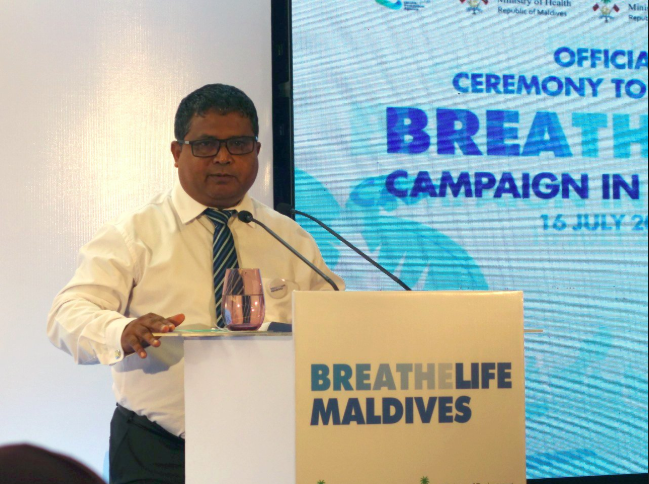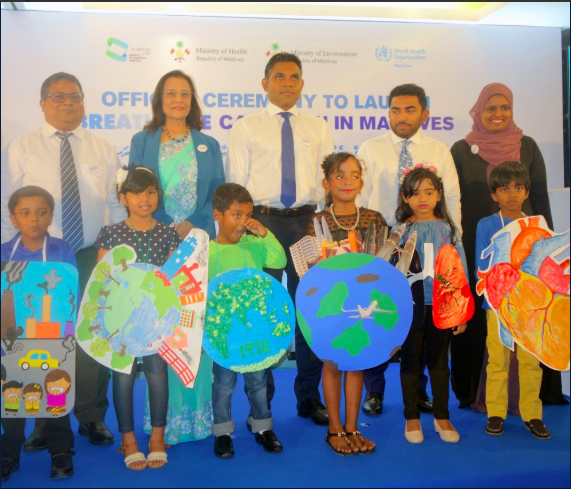Less than a month after the launch of its National Action Plan on Air Pollutants, the Maldives announced its participation in the BreatheLife campaign on an ambitious note.
“Our objective is to have the cleanest and healthiest air quality in the world,” said Minister of Environment, the Republic of Maldives, Dr Hussain Hassan, at the launch event.

“Our objective is to have the cleanest and healthiest air quality in the world.” Minister of Environment, the Republic of Maldives, Dr Hussain Hassan. Photo by WHO SEARO.
Vice President of the Republic of Maldives, Faisal Nasym, launched the country’s participation.
“Air pollution and climate change are two sides of the same coin. The launch of the Breathelife Campaign reflects Maldives’ consistent leadership on both air pollution and climate change,” said Regional Director of WHO’s Southeast Asia Regional Office, Dr Poonam Khetrapal Singh.

Regional Director of WHO’s Southeast Asia Regional Office, Dr Poonam Khetrapal Singh. Photo by WHO SEARO
The Maldives, whose densely-populated capital region Greater Malé is already a BreatheLife member, developed its action plan as part of the Climate and Clean Air Coalition’s Supporting National Action & Planning (SNAP) Initiative, demonstrating the benefits to dovetailing its climate mitigation and air quality goals.
According to the Climate and Clean Air Coalition, the 28 mitigation measures included in the plan are effective in reducing emissions of air pollutants, short-lived climate pollutants and carbon dioxide.
Twenty-two of those mitigation measures are included in the Maldives’ Nationally- Determined Contributions (NDCs) to the Paris Agreement.
Six additional measures in the National Action Plan target major air pollution sources not considered in the Maldives’ climate change plans. These include revising and enforcing emission standards for road vehicles and the marine fleet, which is not currently covered by regulations.
Full implementation of the Plan would lead to a 60 per cent reduction in direct fine particulate pollution (PM2.5) emissions, a 40 per cent reduction in black carbon emissions, and a 27 per cent reduction in nitrogen oxides (NOx) emissions by 2030 compared to projections under a “business as usual” scenario.

BreatheLife Campaign launched by Vice President of the Republic of Maldives, Faisal Nasym, Regional Director of WHO’s SEARO, Dr Poonam Khetrapal Singh, Minister of Health, Abdulla Ameen, and Minister of Environment, Dr Hussain Hassan. Photo by WHO SEARO
The Maldives is made up of almost 1200 islands, with a third of the population living in its capital, Malé. Despite being in the middle of the Indian Ocean, air pollution is a growing concern in the country due to congestion and high population density in the greater Malé region, and from transboundary transport of air pollution from other countries.
More details on Maldives’ national plan: Maldives’ first National Action Plan on Air Pollutants highlights local air pollution benefits of climate action
Stay tuned for more details from the Maldives.
Banner photo by Timo Newton-Syms/CC BY-SA 2.0